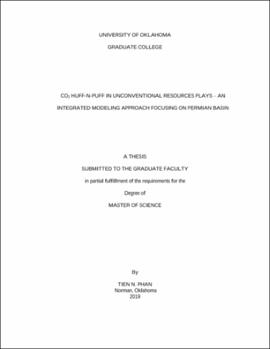| dc.contributor.advisor | Reza, Zulfiquar | |
| dc.contributor.author | Phan, Tien | |
| dc.date.accessioned | 2019-08-01T14:10:08Z | |
| dc.date.available | 2019-08-01T14:10:08Z | |
| dc.date.issued | 2019-08-01 | |
| dc.identifier.uri | https://hdl.handle.net/11244/321088 | |
| dc.description.abstract | Despite the recent growth in oil production from unconventional reservoirs, existing hydraulically fractured horizontal wells face challenges of poor recovery with the rapid production decline over a short life span. Enhanced recovery techniques, such as CO2 huff-n-puff can be a solution to this impending problem and lead to energy independence for the foreseeable future. However, mechanisms occurring around the hydraulically fractured wells are far from fully understood. The primary motivation of this study revolves around addressing this limitation. Specifically, this study explored the evolution of various thermophysical properties occurring around hydraulically fractured wells in liquid-rich unconventional reservoirs using a holistic, integrated modeling framework.
Available well-logs and other data from Howard County in the Midland Basin formed the basis for constructing representative 3D structural models that capture the Midland Basin stratigraphy. A fracture simulator was used to create multistage hydraulic fractures that were integrated into numerical reservoir-flow simulation models. Then, both convective and diffusive flow within a multicomponent compositional simulation modeling paradigm is used to examine the role of molecular diffusion in performance under cyclic CO2 injections in hydraulically fractured well.
The simulation results indicate that molecular diffusion yields an incremental oil recovery of 6% compared to models that do not. Thorough analysis reveals different thermophysical properties transition from near wellbore regions to outer regions into the rock matrix. Changes in total mole fractions of CO2, methane, and hydrocarbons with C7+ fraction, pressure and saturation variation, viscosity reduction and the surface tension over 14 injection-soaking-production cycles are tracked. The analyses of the evolution of these thermophysical properties provide the means to evaluate the efficiency of the solvent injection process. The simulation results explain how, when, and where CO2 disperses into the reservoir. | en_US |
| dc.language | en_US | en_US |
| dc.rights | Attribution 4.0 International | * |
| dc.rights.uri | https://creativecommons.org/licenses/by/4.0/ | * |
| dc.subject | CO2 huff-n-puff | en_US |
| dc.subject | integrated modeling | en_US |
| dc.subject | hydraulic fracture | en_US |
| dc.subject | unconventional EOR | en_US |
| dc.title | CO2 HUFF-N-PUFF IN UNCONVENTIONAL RESOURCES PLAYS – AN INTEGRATED MODELING APPROACH FOCUSING ON PERMIAN BASIN | en_US |
| dc.contributor.committeeMember | Devegowda, Deepak | |
| dc.contributor.committeeMember | Pigott, John | |
| dc.date.manuscript | 2019-07-30 | |
| dc.thesis.degree | Master of Science | en_US |
| ou.group | Mewbourne College of Earth and Energy::Mewbourne School of Petroleum and Geological Engineering | en_US |
| shareok.orcid | 0000-0002-1164-8043 | en_US |

